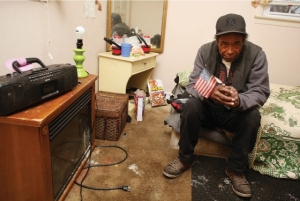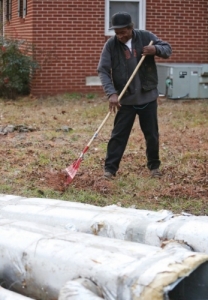90 days later: Part I Condemned in recovery
By Rochelle Moore
Published in News on January 8, 2017 2:29 AM

News-Argus/CASEY MOZINGO
Rudolph Jennings has lived without electricity except for that provided by a generator since Hurricane Matthew hit in early October.

News-Argus/CASEY MOZINGO
Rudolph Jennings cleans up his yard, working around ductwork that was pulled from beneath his home.
Rudolph Jennings lugs a 10-gallon container of gasoline under his carport; fuel for a generator acting as the only source of electricity to his Brock Street home.
Jennings has been without electricity since Hurricane Matthew hit the area hard on Oct. 8 of last year.
He chose to remain inside the single-story brick house, even after city inspectors hung a condemned sign on his door.
Jennings said he isn't too concerned about living without central heat. But he is a little bothered that a contractor pulled ductwork out from under the house and left it lying on his property.
It's been about a month. The contractor, who Jennings said was paid for part of the job, hasn't returned.
"I've been here ever since the flood," he said. "I've been sitting here the whole time. I got an electric heater.
"It ain't hard living like this. You've got to do what you've got to do."
CONDEMNED
PROPERTIES
Jennings lives in one of nearly 400 houses that sustained extensive flooding and were temporarily condemned by the city of Goldsboro's inspections department. Since the condemnation signs went up in early October, an estimated 45 have been removed, after homeowners made required repairs, said Allen Anderson Jr., Goldsboro chief building inspector.
Most of the properties, 310, also had electricity disconnected due to safety and liability concerns. Electricity has since been restored to 114 homes, Anderson said.
The process of recovery has been lengthy, due to a variety of factors. In October and November, the inspections department issued close to 1,400 repair permits, at no cost, more than double the amount typically issued.
"They're just going through the process of trying to get everything fixed," Anderson said. "It takes money to maybe have to redo your heating and air conditioning system, maybe to redo your wiring, so it's just a process.
"It takes time to get this done. A lot of people are waiting on (Federal Emergency Management Agency) money. They're waiting for insurance money. Some are just waiting until they've got money."
Hurricane Matthew brought with it widespread flooding and cut off sections of the city, including neighborhoods along John Street and the adjacent Brock Street area.
Residential areas are dotted with condemnation signs posted on front doors. Contractor signs are posted on front lawns. Ductwork and household materials remain piled on the ground.
Jennings, who lives in a house owned by his sister, said hurricane flooding filled the crawl space under the home. The inside of the house was never damaged. Flooding damaged the heating and air conditioning ductwork, he said.
"There ain't nothing wrong with the house," Jennings said. "The inside of the house is all right."
His sister has been handling the contract work to replace the ductwork, and she's been involved in seeking money through insurance claims, as well as any FEMA assistance, he said. Jennings can't recall the name of the contractor hired by his sister who is in the military and currently deployed overseas, he said.
"She paid him half the money, and he didn't come back and finish the job," Jennings said. "She's trying to get up with him. She's got insurance, and I guess she's waiting on FEMA, too. I don't know if FEMA will help us at all."
Jennings said he only turns on the gas-powered generator when it gets cold, mostly during the evening hours. He said he doesn't need electricity for cooking, either, since he eats at a nearby convenience store.
Jennings says he's spending close to $90 a week for gasoline for the generator. He still needs an electrician to check the electrical system to determine if it needs to be replaced.
His house is one of the 196 without electricity following the disconnection of homes, in October, and one of the estimated 355 homes that remain condemned.
"You've got people who have got the same situation I've got," Jennings said. "You've got people in houses worse than my house is."
'HOME SWEET
HOME'
When the city coordinated the electric disconnections with Duke Energy Progress, part of the concern was that many homes had cloth-covered wiring, which was soaked from the storm.
Some homeowners have had to replace the electrical wiring systems.
Wilbert Broadhurst, who rents a house on Brock Street, said his landlord replaced electrical wiring as well as the ductwork. A condemned sign is still on the front door, but Broadhurst said the property is almost back to normal.
"They rewired everything," he said. "They just turned (the electricity) on about a month ago. I'm straightened out now."
Broadhurst was living with friends from October until early December. He returned home after the electricity was restored. The temporary move was an inconvenience that he's glad is over.
"It threw me off for a minute," he said. "So far, everything's working out OK now.
"Home sweet home -- everything cool now."
Broadhurst, who thought he could remove the condemnation sign, said he plans to contact the city inspections department to see if the sign can be taken down.
COSTLY REPAIRS
Ronnie Matthews, who owns a house on Graham Street, recently had his condemnation sign removed after his heating and air conditioning unit and ductwork were replaced. City inspectors approved the home following repairs and removed the condemnation sign, in mid-December.
"Water got under our house," he said. "It didn't get in the house, and the electric didn't get disturbed. We had to replace the ductwork and the unit. It was over $11,000, but we have flood insurance."
Matthews stayed with his daughter after the house sustained flood damage, the condemnation sign was posted and electricity disconnected.
"We didn't have any power, so we didn't have a chance but to find somewhere else to go," he said. "Basically everything they did, I felt, was just a safety measure."
Matthews was provided with some FEMA immediate loss assistance, which covered the cost of clothing, food and travel. The process of restoring his house took time.
"It was just a lengthy process getting the insurance check," he said. "Everything worked out in the end."
HEALTH RISKS
The city's inspections department continues to provide lists of area contractors for electrical and mechanical repairs and has information about cleaning homes with mold.
Kevin Whitley, environmental health specialist with the Wayne County Health Department, said city and county inspectors are primarily handling discussions with homeowners and advising them about the dangers of mold.
"All we're doing is giving warnings of potential mold and mildew," Anderson said. "The whole reason we (condemned these properties) is because of the health risks."
Whitley said mold growth can occur on porous material, like carpet, furniture, ductwork, sheetrock and other items that can't be cleaned in a washing machine.
High concentrations of mold can lead to allergic illness, trigger asthma, cause respiratory infections and bring about toxic effects, according to the Public Health Epidemiology Section of the N.C. Department of Health and Human Services.
Information about the health effects of mold, proper cleaning methods and other related information is available on the Occupational and Environmental Epidemiology website, within the A-Z contaminants link, at www.epi.publichealth.nc.gov/oee.
HOME SECURITY
Anderson said the Goldsboro Police Department is patrolling areas where the condemned properties are vacant.
"I'm concerned that people's houses could be broken into, but the owners have a responsibility for securing their homes," Anderson said.
Even though condemnation signs are posted, city inspectors are not actively monitoring the houses to see if homeowners are living inside. Anderson said his department does not plan to enforce the temporary condemnations. The signs will be removed after homeowners make repairs that are approved by the inspectors.
"We're not going out looking to put people out of their homes," Anderson said. "They're staying at their own risk.
He asked, rhetorically, if the city put the condemned signs on the homes and made recommendations that people should not remain in their homes and they do, then what can else can be done?
"I guess the question is, where are people going to go?"
